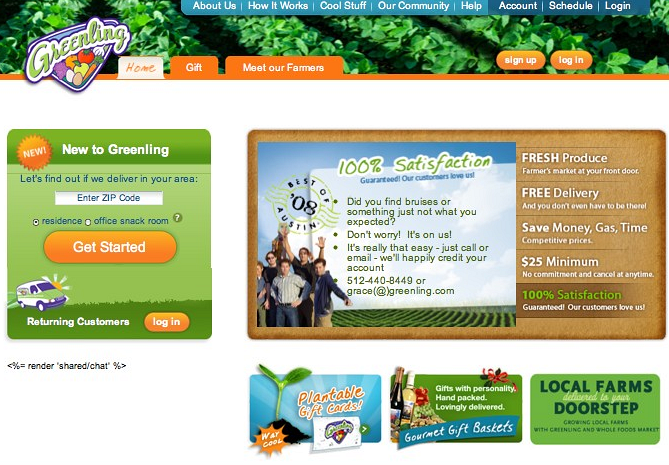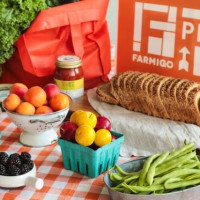We were thrilled to work with Greenling to source almost all of the ingredients used in the dishes created for IdeaCOMM. At the event, Arnold demonstrated how you can use their platform to easily order local, farm-fresh food. In our interview Arnold shares his vision for the future of grocery shopping – a future that minimizes waste and packaging, while making it easier and less time consuming to buy and cook fresh, local food.
DG: What’s your business model? How does your model differ from Webvan?
MA: Webvan’s failure, in my mind, was the result of 2 constraints and one big mistake. Online shopping was just taking off, computer penetration was low, so the customer base was limited. Most groceries are bought by moms and they weren’t online yet in big numbers. They are now. The other constraint was that technology was expensive, especially in the distribution space. They spent tens of millions of dollars creating programs that could be bought as software-as-a-service plug-ins now for hundreds of dollars a month.
Webvan’s mistake was their meteoric expansion. They were actually profitable in their test market, San Francisco. So the pitch for expansion was compelling. But without the customers elsewhere and with each warehouse requiring expensive technology, they were doomed out of the gates.
Greenling took a struggling industry and found where we could deliver real value. We don’t carry general merchandise or even the majority of food items out there. We want to help people cook healthy, fresh meals. We find the best of the best ingredients, all local and/or Organic, and get it to the dinner table faster than anyone else.
DG: Who is your target market?
MA: We want to reach anyone who eats food! We are not about reaching a specific niche, rather growing the local food system by increasing the demand, and making it easy for people eat local. But specifically what drives people to use Greenling? Convenience, desire to eat healthy and passion for supporting local and sustainable agriculture.
DG: What, if any, challenges do you face with sourcing from small farmers? How are you addressing these challenges?
MA: The biggest challenge is unpredictable weather. An unexpected freeze or storm can really set a farmer back. However we work with multiple farmers and can usually get everything we need despite setbacks. Whenever we aren’t able to source something locally, we find a non-local, certified organic source.
It’s also a major logistical challenge to offer so many local & artisan products, created slowly with care and passion, and turn them around so fast. It can literally look like a stock market trading floor as product is coming in and flying around to get into people’s baskets.
DG: How are you using information technology to innovate the way we source, consume, and interact with food?
MA: Farmers who practice sustainable agriculture are up against a lot. Commercial farms can use technology to out-produce and out-price them. We use it to help our farmers, who aren’t interested in using chemicals and GMOs just to grow faster and in larger quantities. Our website does the work to connect with consumers and communicate demand, so farmers can focus on farming! We provide transparency in the local food system found nowhere else. From the comfort of their home, customers can see what farmers are growing and order bundles of goodness or pick and choose their own selections.
DG: I noticed that your ‘In the Local Box’ tab directs visitors to a twitter account that lists products and their associated farm. How does this work?
MA: The Local Box is a weekly offering of the freshest, in-season produce from our local farms. We publish the expected contents (they can change daily based on supply) for the next week in our Friday newsletter, and via social media- Facebook and 2 Twitter accounts: @greenling_local, the one you mentioned, is just local box contents each week; and @greenling_com is our regular account. Once we have the product in, we also post a video so customers can see a visual of the Local Box for the week.
DG: Greenling seems to be really active in the community. Could you describe some of the ways you are driving community engagement?
MA: We love to support like-minded community organizations like the Sustainable Food Center to work together to spread the word. Greenling has a weekly presence at local farmer’s markets to help people learn how easy it is to eat farm fresh produce even when you can’t make it to the market. I also enjoy speaking to groups whenever I can to educate people about the benefits of eating local and why sustainability is so important. Also, we connect with local food bloggers to help our customers with new ideas on how to use the veggies we bring them. We want to reach busy people and they all engage with the community in different ways. So we have to engage in all of those ways to reach everyone.
DG: Why did you participate in IdeaCOMM?
MA: We are always interested in helping expand the conversation about combining technology and sustainable food! Many people are skeptical of how human connections can be maintained online or through technology. We’re showing how to actually increase human connections via technology and IdeaCOMM is highlighting all the wonderful people trying to do the same thing.








